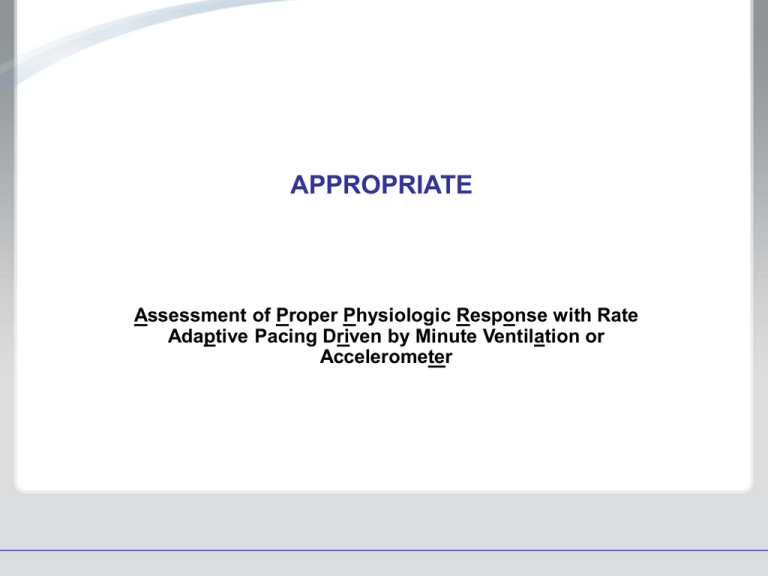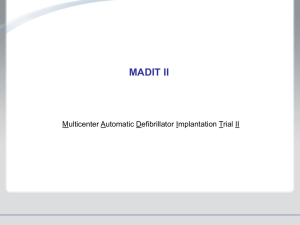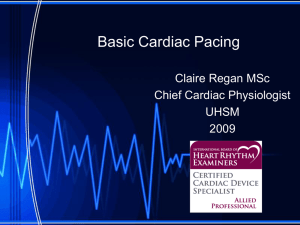
APPROPRIATE
Assessment of Proper Physiologic Response with Rate
Adaptive Pacing Driven by Minute Ventilation or
Accelerometer
DISCLAIMER
Boston Scientific Education and Presentation Resources
•
Boston Scientific develops, manufactures and markets a broad array of products and services that enable lessinvasive care for some of the most threatening cardiac conditions. Its prescription devices for use by healthcare
professionals are regulated by government agencies in each of the countries in which it does business, such as the
Food and Drug Administration in the United States (U.S.) or the Ministry of Health in Japan. These regulations often
restrict the use of the information that can be disclosed to the public. If the format of the material presented is
altered, the appropriate indications, contraindications, precautions, warnings and adverse events should be included.
•
This Presentation has been developed as a service of Boston Scientific. Like any other service, in spite of our best
efforts the information in this Presentation may become out of date over time. Nothing on this Presentation should be
construed as the giving of advice or the making of a recommendation and it should not be relied on as the basis for
any decision or action. The materials on this Web Site are intended for educational purposes only. Boston Scientific
accepts no liability for the accuracy or completeness or use of, nor any liability to update, the information contained
on this Presentation. These materials are provided "AS IS" WITHOUT WARRANTY OF ANY KIND, EITHER
EXPRESSED OR IMPLIED, INCLUDING, BUT NOT LIMITED TO, THE IMPLIED WARRANTIES OF
MERCHANTABILITY, FITNESS FOR A PARTICULAR PURPOSE, OR NON-INFRINGEMENT. Some jurisdictions do
not allow the exclusion of implied warranties, so the above exclusion may not apply to you.
Copyright and Intellectual Property
•
Boston Scientific hereby authorizes you to copy materials published by it on the Cardiac Rhythm Resources Web
Site for non commercial use only, provided any copy of these materials which you make shall retain all copyright and
other proprietary notices and any disclaimer contained thereon and on this Web Site.
•
Nothing contained herein shall be construed as conferring by implication or otherwise any license or right under any
patent or trademark of Boston Scientific or any third party. Except as expressly provided above, nothing contained
herein shall be construed as conferring any license or right under any Boston Scientific copyright.
Illustrations with the mark ©medmovie.com, are Copyright medmovie.com with all rights reserved.
Assessment of Proper Physiologic Response
with Rate Adaptive Pacing Driven by Minute
Ventilation or Accelerometer
Status: Currently enrolling patients
APPROPRIATE will evaluate the clinical superiority
of MV versus XL in a population of CI patients
that are in need of rate-adaptive pacing.
Clinical Relevance
• XL may be insufficient during activities of less motion (carrying weight,
cycling, stair climbing)
• MV has not been evaluated for clinical superiority over XL
• Primary objective:
– Determine whether an improvement in peak VO2 is greater using the
minute ventilation (MV) sensor compared to accelerometer (XL) in CI
patients
• Secondary objectives:
– Heart rate during Activities of Daily Living (ADL) using a lift and carry
test. This test simulates an activity that requires walking while carrying
15 pounds, such as a grandchild or two bags of groceries
– Metabolic chronotropic relationship (MCR) slope
– Exercise time
– VO2 at ventilatory threshold
Study Design
Patient Population
• Eligible study participants are pacemaker-indicated and will receive
an ALTRUA® 60 pacemaker
• Some of the exclusion criteria were
– Mobitz II second degree heart block
– Third degree heart block
– Chronic atrial fibrillation or uncontrolled atrial arrhythmias within the past
90 days prior to consent
– Neuromuscular, orthopedic, or vascular disability that prevents normal
walking or weight carrying
– Symptom-limited exercise protocol is thought to be dangerous or contraindicated
– Indicated for an ICD or CRT-D
• Approximately 60 Centers in the United States
• 1000 patients will be implanted
– Need 380 CI patients to complete 1-month visit
Results
• APPROPRIATE is an on-going trial and has not yet
published results.
CRT-D Systems and Leads from Boston Scientific CRM
Indications
Cardiac Resynchronization Therapy Defibrillators (CRT-Ds) are indicated for patients with moderate to severe heart failure (NYHA III/IV) who remain symptomatic despite
stable, optimal heart failure drug therapy, and have left ventricular dysfunction (EF 35%) and QRS duration 120 ms. Left ventricular coronary venous, steroid-eluting,
pace/sense leads are transvenous leads intended for chronic LV pacing and sensing via the coronary veins when used in conjunction with a compatible pulse generator.
Extended bipolar pacing and sensing is available using dual-electrode LV leads with an RV pace/sense/defibrillation lead or a bipolar RV pace/sense lead.
Contraindications
There are no contraindications for the CRT-D device. Use of LV leads are contraindicated in patients with a hypersensitivity to a nominal dose of 0.45, 0.7 or 1.0 mg
dexamethasone acetate drug. Some LV lead models are contraindicated in patients with mechanical tricuspid heart valves, or obstructed or inadequate vasculature for
intravenous catheterization.
Warnings
Read the product labeling thoroughly before implanting the pulse generator to avoid damage to the system. Such damage can result in patient injury or death. Program the
pulse generator Tachy Mode to Off during implant, explant or postmortem procedures to avoid inadvertent high voltage shocks. Always have sterile external and internal
defibrillator protection available during implant. If not terminated in a timely fashion, an induced tachyarrhythmia can result in the patient’s death. Ensure that an external
defibrillator and medical personnel skilled in CPR are present during post-implant device testing should the patient require external rescue. Patients should seek medical
guidance before entering environments that could adversely affect the operation of the active implantable medical device, including area protected by a warnng notice that
prevents entry by patients who have a pulse generator. Do not expose a patient to MRI device scanning. Strong magnetic fields may damage/interfere with the device and
lead system and cause injury to the patient. Do not subject a patient with an implanted pulse generator and lead system to diathermy since diathermy may cause fibrillation,
burning of the myocardium, and irreversible damage to the pulse generator because of induced currents. Do not use atrial tracking modes in patients with chronic refractory
atrial tachyarrhythmias. Tracking of atrial arrhythmias could result in VT or VF. Do not use atrial only modes in patients with heart failure because such modes do not
provide CRT. LV lead dislodgment to a position near the atria can result in atrial oversensing and LV pacing inhibition. Physicians should use medical discretion when
implanting this device in patients who present with slow VT. Programming therapy for slow monomorphic VT may preclude CRT delivery at faster rates if these rates are in
the tachyarrhythmia zones. Do not kink leads. Kinking leads may cause additional stress on the leads, possibly resulting in lead fracture. Do not use defibrillation patch
leads with the CRT-D system, or injury to the patient may occur. Do not use this pulse generator with another pulse generator. This combination could cause pulse
generator interaction resulting in patient injury or lack of therapy delivery. For specific models, when using a subpectoral implantation, place the pulse generator with the
serial number facing away from the ribs. Implanting the pulse generator subpectorally with the serial number facing the ribs may cause repetitive mechanical stress to a
specific area of the titanium case, potentially leading to a component failure and device malfunction. When using a RV pace/sense lead in conjunction with an LV pacing
lead, it is recommended that a polyurethane-insulated lead be used. Failure to observe this warning could result in insulation damage of the RV lead, which can cause a
periodic or continual loss of pacing, sensing or both. Lead fracture, dislodgment, abrasion or an incomplete connection can cause a periodic or continual loss of pacing,
sensing or both. The use of battery-powered equipment is recommended during lead implantation and testing to protect against fibrillation that might be caused by leakage
currents. Line-powered equipment used in the vicinity of the patient must be properly grounded. The lead connector must be insulated from any leakage currents that could
arise from line-powered equipment. The lead is not designed to tolerate excessive flexing, bending, tension or injection pressure. This could cause structural weakness,
conductor discontinuity or lead dislodgment. When using a finishing wire accessory kit, use the corresponding finishing wire model for the lead length If the wrong length
finishing wire is used, the finishing wire tip may extend out of the distal end of the lead or not stabilize the lead properly. When placing the lead with a stylet, use only a stylet
designed for use with the ACUITY Steerable lead. These stylets are specifically designed to prevent the stylet from extending past the lead tip. Extending the stylet past the
lead tip may cause tissue damage.
Precautions
For information on precautions, refer to the following sections of the PG product labeling: clinical considerations, sterilization, storage and handling, implant and device
programming, follow-up testing, explant and disposal, environmental and medical therapy hazards; hospital and medical environment; home and occupational
environments. Advise patients to avoid sources of electromagnetic interference (EMI) because EMI may cause the pulse generator to deliver inappropriate therapy or inhibit
appropriate therapy. Refer to the following sections of the lead product labeling: sterilization and handling, and lead evaluation and implantation for cautions specific to
handling, implanting, and testing the lead. Failure to observe these cautions could result in incorrect lead implantation, lead damage/dislodgment, or harm to the patient. It
has not been determined whether the warnings, precautions, or complications usually associated with injectable dexamethasone acetate apply to the use of the low
concentration, highly localized, controlled-release device. For a listing of potentially adverse effects, refer to the Physician’s Desk Reference.
Potential Adverse Events
Potential adverse events from implantation of the CRT-D system include, but are not limited to, the following: allergic/physical/physiologic reaction, death,
erosion/migration, fibrillation or other arrhythmias, lead or accessory breakage (fracture/insulation/lead tip), hematoma/seroma, inappropriate or inability to provide therapy
(shocks/pacing/sensing), infection, procedure-related, psychologic intolerance to an ICD system – patients susceptible to frequent shocks despite antiarrhythmic medical
management/imagined shocking, and component failure. In rare cases severe complications or device failures can occur.
Refer to the product labeling for specific indications, contraindications, warnings/ precautions and adverse events. Rx only.
(Rev. K)
ICD Systems and Leads from Boston Scientific CRM
ICD/Lead Indications and Usage
ICDs are intended to provide ventricular antitachycardia pacing and ventricular defibrillation for automated treatment of life threatening ventricular arrhythmias. ICDs with
atrial therapies are also intended to provide atrial antitachycardia pacing and atrial defibrillation treatment in patients who have, or are at risk of developing, atrial
tachyarrhythmias. ICD leads provide pacing and rate-sensing and deliver cardioversion and defibrillation shocks for ICD systems.
Contraindications
ICD systems are contraindicated in: Patients whose ventricular tachyarrhythmias may have reversible cause, such as 1) digitalis intoxication, 2) electrolyte imbalance, 3)
hypoxia, or 4) sepsis, or whose ventricular tachyarrhythmias have a transient cause, such as 1) acute myocardial infarction, 2) electrocution, or 3) drowning. Patients who
have a unipolar pacemaker. ICD leads are contraindicated in: patients with a hypersensitivity to a single dose of approximately 1.0 mg of dexamethasone sodium phosphate
and/or 1.0 mg of dexamethasone acetate, or patients with mechanical tricuspid heart valves.
Warnings
Read the product labeling thoroughly before implanting the pulse generator to avoid damage to the ICD system. Such damage can result in patient injury or death. Program
the pulse generator ventricular Tachy Mode to Off during implant, explant or post-mortem procedures to avoid inadvertent high voltage shocks. Always have sterile external
and internal defibrillator protection available during implant. If not terminated in a timely fashion, an induced tachyarrhythmia can result in the patient’s death. Ensure that an
external defibrillator and medical personnel skilled in cardiopulmonary resuscitation (CPR) are present during post-implant device testing should the patient require external
rescue. Patients should seek medical guidance before entering environments that could adversely affect the operation of the active implantable medical device, including
area protected by a warnng notice that prevents entry by patients who have a pulse generator. Do not expose a patient to MRI device scanning. Strong magnetic fields may
damage the device and cause injury to the patient. . Do not subject a patient with an implanted pulse generator to diathermy since diathermy may cause fibrillation, burning of
the myocardium, and irreversible damage to the pulse generator because of induced currents. Do not use atrial tracking modes (or an AVT device) in patients with chronic
refractory atrial tachyarrhythmias. Tracking of atrial arrhythmias could result in VT or VF. (Applies to dual-chamber devices only.) Do not use this pulse generator with another
pulse generator. This combination could cause pulse generator interaction resulting in patient injury or lack of therapy delivery. Do not kink leads. Kinking leads may cause
additional stress on the leads, possibly resulting in lead fracture. For specific models, when using a subpectoral implantation, place the pulse generator with the serial number
facing away from the ribs. Implanting the pulse generator subpectorally with the serial number facing the ribs may cause repetitive mechanical stress to a specific area of the
titanium case, potentially leading to a component failure and device malfunction. Do not attempt to use the lead system with any device other than a commercially available
ICD with which it has been tested and demonstrated safe and effective - potential adverse consequences include, but are not limited to, undersensing of cardiac therapy and
failure to deliver necessary therapy. The safety and efficacy of the tip electrode placement above midseptum has not been clinically established (extendable retractable helix
leads). Lead fracture, dislodgment, abrasion and/or incomplete connection can cause a periodic or continual loss of rate-sensing, possibly resulting in inappropriate delivery
of a PG shock or inadequate delivery of converting energy. The lead is not designed to tolerate excessive flexing, bending or tension. This could cause structural weakness,
conductor discontinuity and/or lead dislodgment. Failure to obtain appropriate electrode position may result in higher defibrillation thresholds or may render lead unable to
defibrillate a patient whose tachyarrhythmia(s) might otherwise be convertible by an ICD system. In order to deliver defibrillation therapy, the single-coil lead must be
implanted with a separate defibrillation electrode. BSC recommends using the single-coil lead with a pectorally implanted device that uses the metallic housing as a
defibrillation electrode. When connecting the lead to ECD cables and/or the ICD PG it is very important that proper connections are made. Damage to the heart could result if
a high-voltage defibrillating pulse were to be delivered through the pace/sense tip electrode. Use of any component of the lead system to assist in the delivery of externalsource rescue shocks could cause extensive tissue damage. Do not kink, twist or braid the lead terminals, as doing so could cause lead insulation abrasion damage.
Precautions
For information on precautions, refer to the following sections of the ICD product labeling: clinical considerations, sterilization, storage and handling; implantation and device
programming; follow-up testing; explant and disposal; environmental and medical therapy hazards; hospital and medical environments; home and occupational environments.
Advise patients to avoid sources of electromagnetic interference (EMI) because EMI may cause the pulse generator to deliver inappropriate therapy or inhibit appropriate
therapy. Refer to the lead product labeling for cautions specific to handling, implanting and testing the lead. Failure to observe these cautions could result in incorrect lead
implantation, lead damage, and/or harm to the patient. It has not been determined whether the warnings, precautions or complications usually associated with injectable
dexamethasone sodium phosphate/acetate apply to the use of the low concentration, highly localized, controlled-release device. For a listing of potentially adverse effects,
refer to the Physician’s Desk Reference. Tricuspid valvular disease may be exacerbated by the presence of a lead. Use medical judgment when deciding to place a lead in a
patient with triscuspid valvular disease. The lead and its accessories are intended only for one-time use. Do not reuse.
Potential Adverse Events
Potential adverse events from implantation of the ICD/lead system include, but are not limited to the following: allergic/physical/physiologic reaction, death, erosion/migration,
fibrillation or other arrhythmias, lead or accessory breakage (fracture/insulation/lead tip), hematoma/seroma, inappropriate or inability to provide therapy
(shocks/pacing/sensing), infection, procedure related, psychologic intolerance to an ICD system - patients susceptible to frequent shocks despite antiarrhythmic medical
management/imagined shocking, and component failure. In rare cases severe complications or device failures can occur.
Refer to the product labeling for specific indications, contraindications, warnings/ precautions and adverse events. Rx only.
(Rev. H)
Pacing Systems and Leads from Boston Scientific CRM
Indications
Pacemaker indications include: symptomatic paroxysmal or permanent second- or third-degree AV block; symptomatic bilateral bundle branch block; symptomatic
paroxysmal or transient sinus node dysfunction with or without associated AV conduction disorders; bradycardia-tachycardia syndrome, to prevent symptomatic bradycardia
or some forms of symptomatic tachyarrhythmias; neurovascular (vaso-vagal) syndromes or hypersensitive carotid sinus syndromes. Adaptive-rate pacing is indicated for
patients who may benefit from increased pacing rates concurrent with increases in minute ventilation and/or level of physical activity. Pacemakers’ dual-chamber and atrial
tracking modes are also indicated for patients who may benefit from maintenance of AV synchrony. Dual-chamber modes are specifically indicated for: conduction disorders
that require restoration of AV synchrony, including varying degrees of AV block; VVI intolerance (eg, pacemaker syndrome) in the presence of persistent sinus rhythm.
Pacing leads from BSC CRM are intended for chronic pacing and sensing of the atrium and/or ventricle when used with a compatible pulse generator.
Contraindications
Pacemakers are contraindicated for the following patients under the circumstances listed: patients with unipolar pacing leads or in MV mode with an implanted ICD
because it may cause unwanted delivery or inhibition of ICD therapy; use of the MV sensor in patients with only unipolar leads, because a bipolar lead is required in either
the atrium or the ventricle for MV detection; single-chamber atrial pacing in patients with impaired AV nodal conduction; atrial tracking modes for patients with chronic
refractory atrial tachyarrhythmias, which might trigger ventricular pacing; dual-chamber and single-chamber atrial pacing in patients with chronic refractory atrial
tachyarrhythmias; asynchronous pacing in the presence (or likelihood) of competition between paced and intrinsic rhythms. Pacing leads from BSC CRM are also
contraindicated in: patients with a hypersensitivity to a single dose of approximately 1.0 mg of dexamethasone sodium phosphate and/or 1.0 mg of dexamethasone acetate,
patients with tricuspid valvular disease, patients with mechanical tricuspid heart valves, patients with an allergy to mannitol.
Warnings
Read the product labeling thoroughly before implanting the pulse generator to avoid damage to the system. Such damage can result in patient injury or death .
Inappropriate sustained high-rate pacing occurred in the PULSAR MAX clinical study in 5 out of 130 patients with MV ON, 4 to 14 days after implant. If sustained high-rate
pacing could be of concern, consider programming a reduced Max Sensor Rate or MV to Passive. These programming recommendations are intended to assure that MV
calibration is evaluated and, if necessary, recalibrated (4 ON) when the patient and pacing system have stabilized post implant. Continued monitoring of the MV sensor
performance should be performed at all follow-up visits until implant stabilization has occurred. The use of battery-powered equipment is recommended during lead
implantation and testing to protect against fibrillation that might be caused by alternating currents. Line-powered equipment used in the vicinity of the patient must be
properly grounded. The lead connector must be insulated from any leakage currents that could arise from line-powered equipment.
Precautions
For information on precautions, refer to the following sections of the PG product labeling: clinical considerations, sterilization, storage and handling, lead evaluation and
connection, implantation, programming and pacemaker operation, MV initialization, environmental and medical therapy hazards. Advise patients to avoid sources of electric
or magnetic interference (EMI). If the pacemaker inhibits or reverts to asynchronous operation at the programmed pacing rate or at the magnet rate while in the presence of
the EMI, moving away from the source or turning it off will usually allow the pulse generator to return to its normal mode of operation. Refer to the lead product labeling for
cautions specific to handling, implanting, and testing the lead. Failure to observe these cautions could result in incorrect lead implantation, lead damage/dislodgment, or
harm to the patient. It has not been determined whether the warnings, precautions or complications usually associated with injectable dexamethasone sodium
phosphate/acetate apply to the use of the low concentration, highly localized, controlled-release device. For a listing of potentially adverse effects, refer to the Physician’s
Desk Reference.
Potential Adverse Events
Potential adverse events from implantation of the pacing system include, but are not limited to, the following: allergic/physical/physiologic reaction, death, erosion/migration,
fibrillation or other arrhythmias, lead or accessory breakage (fracture/insulation/lead tip), hematoma/seroma, inappropriate or inability to provide therapy (pacing/sensing),
infection, procedure-related, and component failure. In rare cases severe complications or device failures can occur.
Refer to the product labeling for specific indications, contraindications, warnings/precautions and adverse events. Rx only.
(Rev. J)












